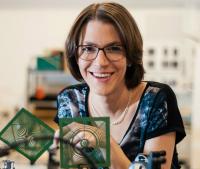Innovative skin cancer detection solution

Agnieszka Siemion, Ph.D., Eng., and her team will be working on the T-SKIN project until the end of 2021; photo: Andrzej Siemion
A team led by Agnieszka Siemion, Ph.D., Eng., of the Warsaw University of Technology Faculty of Physics is working on optical systems for a real-time human skin imaging device designed to detect cancer lesions. The T-SKIN project received funding under the LEADER Program managed by the National Centre for Research and Development.
The essential components of the device will be optical modules with diffraction structures. Those structures harness diffraction, which involves bending and, as a result, a change in direction of waves as they meet a barrier in their path.
The scientists intend to create a system to illuminate and map the skin (in order to identify tumor tissue) and a system which will focus radiation into a spot of a high power density and a system that will redirect and deliver radiation reflected at various angles to a detector or an array of detectors (to enable examination of deeper skin layers).
Patients’ and physicians’ comfort
“Our project uses terahertz radiation,” says Doctor Siemion. “It offers the advantage of enabling the tumor tissue to be distinguished from the healthy tissue. In addition, unlike the familiar and commonly applied X-rays, THz is not harmful to humans because it is not an ionizing radiation.”
If the solution being developed by the scientists of the Warsaw University of Technology was implemented, it could significantly improve the patients’ comfort. Illumination of the tumor tissue with the terahertz radiation produces images which are equivalent to histopathology images. This means that the results would be available instantly without having to wait for them for weeks. Moreover, this skin-testing method would be non-invasive but precise enough to determine the size of the tumor in order to excise it without removing excessive amounts of the surrounding healthy tissue.
Matching is key
However, the application of the terahertz radiation also come with challenges.
“Generally, T-rays have a massive range of frequency compared to the wave range of the visible spectrum,” says Doctor Siemion. “In this project, we are going to focus on 2 to 3 selected frequencies and will have to tailor a source-detector assembly to match each of them. Regrettably, these solutions are still not cheap, but we need to match our optical modules to them, so that the overall device could achieve robust performance.”
Another bump on the road is one other property of the terahertz radiation: it is blocked by water. “That is why in order to be able to examine deeper skin layers, we will try to maximize the energy supply,” says Doctor Siemion.
Testing, testing and testing
The team plans to check how the finished optical modules work both with the equipment available at the Faculty of Physics and with a commercial source and detector. Some of the measurements will be performed at the Military University of Technology. Collecting as much data as possible will be extremely useful not only to prove the efficiency of the modules but also to develop an algorithm for designing such modules.
The scientists also want to develop a skin dummy for the purposes of the LEADER project. This would ensure that their tests reflect the real-world testing as closely as possible. Preferably, such testing should be done on real tissue so the team is on the lookout for opportunities to partner with healthcare professionals / hospitals.
The target solution could be truly compact as the diffraction structures alone are thin and lightweight. The ultimate size is determined by the source and the detector.
The solution that is being developed by Doctor Siemion’s team is the future of medicine. Yet, like with all other innovations for human life and health, the journey to the market is long and winding, with plenty of studies and testing along the way.
Agnieszka Kapela
Promotion and Information Office
Project duration: January 1, 2019 to December 31, 2021
The project is funded under the LEADER IX Program by the National Centre for Research and Development.







